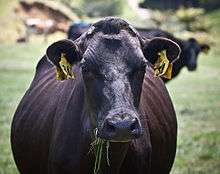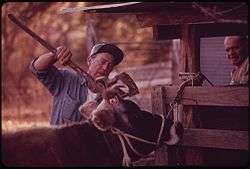Livestock dehorning
Dehorning is the process of removing the horns of livestock. Cattle, sheep, and goats are sometimes dehorned[1][2] for economic and safety reasons. Disbudding is a different process with similar results; it cauterizes and thus destroys horn buds before they have grown into horns. Disbudding is commonly performed early in an animal's life, as are other procedures such as docking and castration.

Many breeds of cattle and sheep are naturally hornless. The polled gene can occur naturally in particular breeds or easily manipulated during breeding to lack horns, therefore do not need to be dehorned or disbudded. Although polling is common among cattle and sheep, a variety of livestock species cannot easily be bred to lack horns naturally. In one case, the poll gene in goats was linked to hermaphrodism in a single study several decades ago, although fertile polled goats have been bred.[3]
Horns are removed because they can pose a risk to humans, other animals and to the bearers of the horns themselves (horns are sometimes caught in fences or prevent feeding). Dehorning is normally performed with local anesthesia and sedation by a veterinarian or a trained professional.[4] Removal of larger horns is usually performed during spring and autumn to avoid fly season. In very large horns, "tipping" (removal of the tip of the horn) may be recommended to minimize bleeding. Dehorning is not routinely performed, since it is a difficult and painful process for the animal. Instead, most breeders disbud their animals while young, when the process is quick and easy.[5] Dehorning is controversial because of the pain it causes.[6]
Rationale
Removal
Reasons invoked in support of dehorning animals include the following:
- Horns may cause injuries to handlers or other animals.
- Horned animals take up more space, causing issues at the feed bunk and during transportation.
- Horned animals may require specialized equipment, such as feeders and angulate crushes.
- In some breeds and in some individuals, horns may grow towards the head, eventually causing injury.
- Horns may become broken, causing blood loss and potential for infection.
- Horned animals may become trapped in fences or vegetation, causing self-injury.
Remaining horned
Arguments against dehorning include the following:
- Dehorning (removing fully grown horns) without the use of anesthesia is extremely painful to the animal.[7][8] A 2011 study that surveyed 639 farmers found that 52% of farmers reported that disbudding caused pain lasting more than 6 hours, that only 10 percent of the farmers used local anesthesia before cauterization, 5 percent provided calves with postoperative analgesia, and that farmers "indicated limited willingness to pay the cost of analgesia or to call a veterinarian to perform the procedure."[9]
- Horned livestock are better able to defend themselves and their young from predators such as wolves and dogs.
- Horns provide a secure point for roping or holding the animal's head.
- Horns are traditional in some breeds, and breed standards may require their presence (for example, Texas Longhorn, Highland and White Park cattle).
- In some areas horns are of cultural significance, often being decorated or even trained into strange shapes.
- Some types of yokes used by draught oxen require the presence of horns.
- In very hot climates, horns are useful for thermoregulation and cooling.
Procedure


Dehorning can be performed on older animals and is normally performed with local anesthesia (cornual nerve block) by a veterinarian or a trained professional. Removal of larger horns is usually performed during spring and autumn to avoid fly season.[5] Sedation may be recommended, especially for larger animals that require increased restraint. Use of longer-term pain medicine, like nonsteroidal anti-inflammatory drugs, is being researched in the US to ensure food safety.
For mature cattle that were not dehorned when they were young, another common practice to cut off only the pointed end of the horn. This practice is called horn tipping; it is less stressful on the animal because there is no blood loss and the horn is cut off where there are no longer any nerve endings.[5] This practice does not eliminate the bruising damage done by the horns when cows fight, but it does eliminate the risk of puncture wounds and eye loss from pointed horns.
Disbudding minimizes discomfort and risk, and is performed when horns are small "buds" by one of several methods:
- Cauterization is the process of killing the growth ring of the horn using heat. This process is done when cattle are very young, no more than three or four weeks old—that way the horns are not very big. The earlier in the calf's life cauterization is done, the less pain and stress is inflicted on the calf. Cauterization is usually done with a dehorning hot iron after the area is numbed with local anesthesia.
- A curved knife can be used to cut the horn off when the calf is younger than a couple of months old. It is a simple procedure where the horn and the growth ring is cut off to remove the horn.
- For under eight months of age, but after the horns are starting to grow attached to the skull, so a cup dehorner or a Gigli saw, a type of surgical cutting wire, is used.[10] There are several different types of cup dehorners, but they all serve the same function of removing the horn and growth ring. Since the horn is tougher it takes more force to remove it so tools that provide some leverage are need. Gigli saw wire is used on horns of older calf's horns that have grown too large for the cup dehorners.
- The most recent development in dehorning technology is use of a caustic dehorning paste. The paste is used on calves at less than two days old. The hair around the horn is trimmed back and then the paste is spread all over the horn bud and around the base of the horn on the growth cells. The paste kills the growth ring of the horn and then the horn falls off like a scab when it is healed.[10] However, this method bears a risk of the paste causing injury to the animal's eyes or other tissues if used during periods of rain.
Restraint methods
The animal to be dehorned is usually restrained, either using a dehorning table or with chemical restraint —sedation. This ensures that the dehorning procedure can be done safely and properly. Young calves are run through a head gate (similar to a cattle crush) or haltered. Calves more than a few months old are held in a head gate and their head restrained with a dehorning table or chin bar. Smaller animals like sheep and goats may be restrained by hand or with use of halters.
Pain control
In 2007, the U.S. Department of Agriculture's (USDA) National Animal Health Monitoring System (NAHMS) survey suggested that most cattle in the U.S. were disbudded or dehorned without the use of anesthesia at that time. The survey showed that more than nine out of ten dairy farms practiced dehorning, but fewer than 20 percent of cattle dairy operations used analgesics or anesthesia during the process. While animal rights groups, like the Humane Society of the United States, condemn the practice of dehorning, ending it would mean increased horn-related injuries to cattle and humans. Polled genetics, long a staple in beef cattle breeding are becoming more popular among dairy farmers, with more polled calves being born to dairy cattle every year. Genetic testing can now determine if cattle carry genes for growing horns.[11]
Public debate
In 2018 a referendum was held in Switzerland on providing additional subsidies to farmers that did not dehorn their livestock (between 75–90% of livestock in Switzerland had their horns removed).[12] The referendum was a result of farmer Armin Capaul collecting over 100,000 signatures for a vote on the issue. However, the proposal was opposed by the government and rejected by voters.[13]
References
- "RCVS List of Mutilatory Procedures". Retrieved 9 December 2011.
- "Pain in animals". Archived from the original on 20 May 2013. Retrieved 3 October 2012.
- Eaton, Orson (July 1, 1994). "The Relation Between Polled and Hermaphroditic Characteristics in Diary Goats". Bureau of Animal Industry, U.S. Department of Agriculture, Washington, D.C.: 11.
- Seykora, Tony. "Practical Techniques for Diary Farmers" (PDF). University of Minnesota Extension. Retrieved November 5, 2019.
- "Dehorning Calves" (PDF). University of Tennessee Agricultural Extension. 2004. Retrieved 17 December 2013.
- "Dehorning and Disbudding of Cattle" (PDF). American Veterinary Medical Association. 2014-07-15.
- Hemsworth, P.H.; Barnett, J.L.; Beveridge, L.; Matthews, L.R. (1995). "The welfare of extensively managed dairy cattle - a review". Applied Animal Behaviour Science. 42 (3): 161–182. doi:10.1016/0168-1591(94)00538-p.
- "Peta video on dairy dehorning". Peta. Retrieved 17 October 2012.
- Gottardo, Flaviana; et al. (November 2011). "The dehorning of dairy calves: practices and opinions of 639 farmers". Journal of Dairy Science. 94 (11): 5724–5734. doi:10.3168/jds.2011-4443. PMID 22032397.
- Beattie, William A. (1990). Beef Cattle Breeding & Management. Popular Books, Frenchs Forest. ISBN 0-7301-0040-5.
- "USDA NAHMS Dairy 2007". USDA NAHMS Online. January 2010. Archived 2017-02-13 at the Wayback Machine (accessed 17 December 2013)
- Are cows happier with their horns? Swiss Info, 26 October 2018
- Swiss vote no in sovereignty referendum BBC News, 25 September 2018
External links
| Wikimedia Commons has media related to Dehorned cattle. |